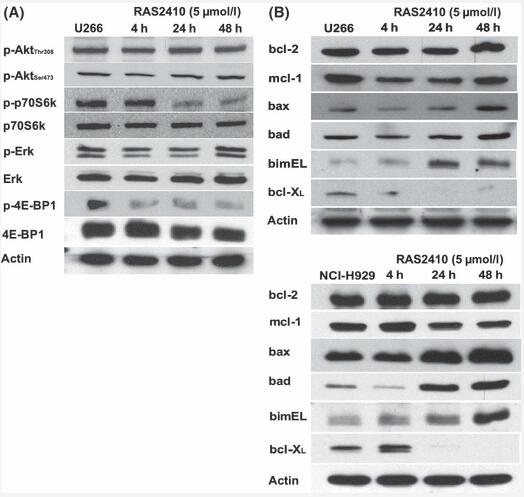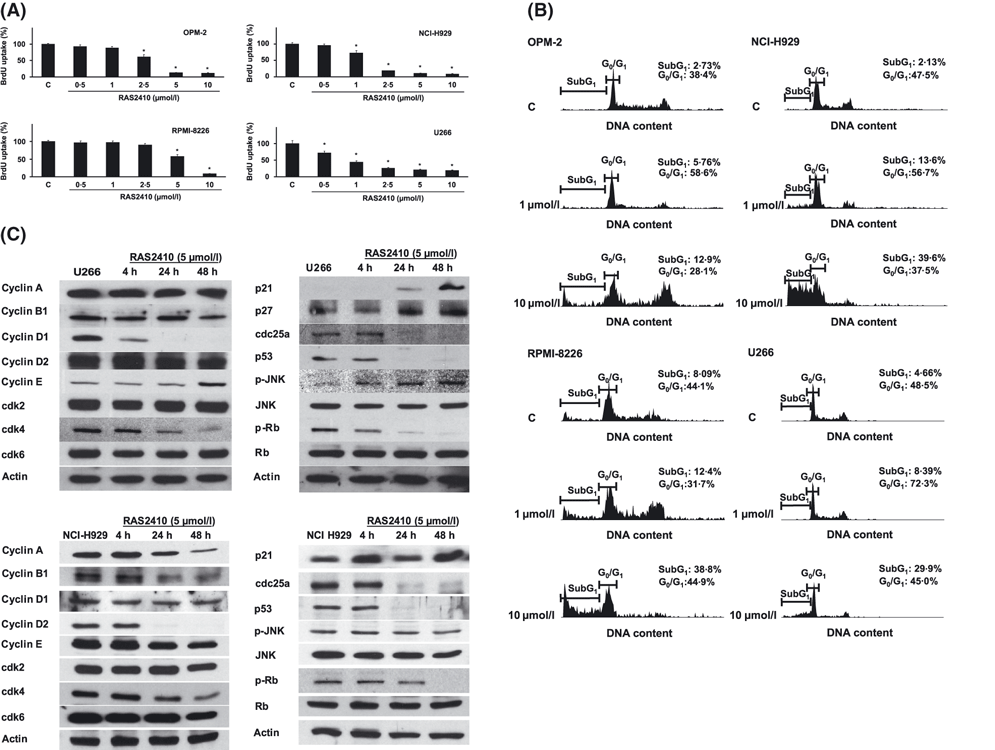
| Size | Price | Stock | Qty |
|---|---|---|---|
| 25mg |
|
||
| 50mg |
|
||
| Other Sizes |
|
Purity: ≥98%
Resminostat (formerly RAS-2410; 4SC-201) is a potent inhibitor of classes I and II HDACs (histone deacetylases) such as HDAC1/3/6 with potential anticancer activity. With IC50 values between 43 and 72 nmol/L, it inhibits HDAC1/3/6. Both in vivo and in vitro antitumor efficaciousness are strong points of this substance. 4SC is exploring the use of resminostat as a liver cancer treatment partner with Yakult in Japan.
| Targets |
HDAC1 ( IC50 = 42.5 nM ); HDAC3 ( IC50 = 50.1 nM ); HDAC6 ( IC50 = 71.8 nM ); HDAC8 ( IC50 = 877 nM )
|
||
|---|---|---|---|
| ln Vitro |
|
||
| ln Vivo |
|
||
| Enzyme Assay |
A 96-well microtitre plate is filled with 40 microliters of enzyme buffer (15 mM Tris HCl pH 8.1, 0.25 mM EDTA, 250 mM NaCl, 10% v:v glycerol) containing HDAC1, 3, 6, or 8 activity, 29 microliters of enzyme buffer, and 1 microliter of resminostat [HCl] at varying concentrations. The reaction is initiated by adding 30 microliters of substrate peptide Ac-NH-GGK(Ac)-AMC (HDAC1, 3 and 6 assays, final concentrations of 6 μM for HDAC1, 10 μM for HDAC6, and 25 μM for HDAC3/DAD) or Ac-RHK(Ac)K(Ac)-AMC (HDAC8 assay, final concentration 50 μM). The reaction is stopped by adding 25 μL of stop solution (50 mM Tris HCl pH 8, 100 mM NaCl, 0.5 mg/mL trypsin, and 2 μM trichostatin A [TSA]) after the enzymes have been incubated for 180 min (HDAC1, HDAC6, HDAC8) or 120 min (HDAC3) at 30°C. The quantification of AMC produced by tryptic cleavage of the deacetylated peptide is done using a Wallac Victor2 1420 multilabel counter (extinction 355 nm, emission 460 nm) following an additional 40 minutes of room temperature incubation. The fluorescence in wells without test compound (1% DMSO, negative control) is set to 100% enzymatic activity for the calculation of the 50% inhibitory concentration (IC50) values, while the fluorescence in wells with 2 μM TSA (positive control) is set to 0% enzymatic activity (background fluorescence substracted)[1].
|
||
| Cell Assay |
The antiproliferative effect of resminostat on HNSCC cells is examined using a CCK-8 cell proliferation assay. Three × 105 cells per well are seeded into 96-well plates. Following a 24-hour growth period, the cells undergo treatment with resminostat and cisplatin, either separately or in conjunction, and are then incubated for a full 72 hours. Equal amounts of dimethylsulfoxide were used as a control group along with untreated cells that were kept in RPMI. CCK-8 is used to measure the proliferation of cells after 72 hours. Three times, each experiment is conducted in triplicate[2].
|
||
| Animal Protocol |
|
||
| References |
|
||
| Additional Infomation |
Resminostat is an enamide resulting from the formal condensation of the carboxy group of (2E)-3-[1-({4-[(dimethylamino)methyl]phenyl}sulfonyl)-1H-pyrrol-3-yl]prop-2-enoic acid with the amino group of hydroxylamine. It is an orally bioavailable inhibitor of histone deacetylases with potential antineoplastic activity. It has a role as an EC 3.5.1.98 (histone deacetylase) inhibitor, an antineoplastic agent and an apoptosis inducer. It is a member of benzenes, a sulfonamide, a member of pyrroles, a tertiary amino compound, a hydroxamic acid and an enamide.
Resminostat has been used in trials studying the treatment of Sezary Syndrome, Mycosis fungoides, Hodgkin's Lymphoma, Hepatocellular Carcinoma, and Lymphoma, T-Cell, Cutaneous, among others. Resminostat is an orally bioavailable inhibitor of histone deacetylases (HDACs) with potential antineoplastic activity. Resminostat binds to and inhibits HDACs leading to an accumulation of highly acetylated histones. This may result in an induction of chromatin remodeling, inhibition of the transcription of tumor suppressor genes, inhibition of tumor cell division and the induction of tumor cell apoptosis. HDACs, upregulated in many tumor types, are a class of enzymes that deacetylate chromatin histone proteins. Drug Indication Treatment of Cutaneous T-Cell Lymphoma |
| Molecular Formula |
C16H19N3O4S
|
|---|---|
| Molecular Weight |
349.4
|
| Exact Mass |
349.109
|
| Elemental Analysis |
C, 55.00; H, 5.48; N, 12.03; O, 18.32; S, 9.18
|
| CAS # |
864814-88-0
|
| Related CAS # |
1187075-34-8 (HCl); 864814-88-0(free base)
|
| PubChem CID |
11609955
|
| Appearance |
Solid powder
|
| Density |
1.3±0.1 g/cm3
|
| Index of Refraction |
1.600
|
| LogP |
1.69
|
| Hydrogen Bond Donor Count |
2
|
| Hydrogen Bond Acceptor Count |
5
|
| Rotatable Bond Count |
6
|
| Heavy Atom Count |
24
|
| Complexity |
548
|
| Defined Atom Stereocenter Count |
0
|
| SMILES |
S(C1C=CC(CN(C)C)=CC=1)(N1C=CC(/C=C/C(=O)NO)=C1)(=O)=O
|
| InChi Key |
FECGNJPYVFEKOD-VMPITWQZSA-N
|
| InChi Code |
InChI=1S/C16H19N3O4S/c1-18(2)11-13-3-6-15(7-4-13)24(22,23)19-10-9-14(12-19)5-8-16(20)17-21/h3-10,12,21H,11H2,1-2H3,(H,17,20)/b8-5+
|
| Chemical Name |
(E)-3-[1-[4-[(dimethylamino)methyl]phenyl]sulfonylpyrrol-3-yl]-N-hydroxyprop-2-enamide
|
| Synonyms |
RAS2410; RAS-2410; RAS2410; RAS 2410; 4SC201; 4SC-201; 4SC 201; Resminostat
|
| HS Tariff Code |
2934.99.9001
|
| Storage |
Powder -20°C 3 years 4°C 2 years In solvent -80°C 6 months -20°C 1 month |
| Shipping Condition |
Room temperature (This product is stable at ambient temperature for a few days during ordinary shipping and time spent in Customs)
|
| Solubility (In Vitro) |
|
|||
|---|---|---|---|---|
| Solubility (In Vivo) |
Note: Listed below are some common formulations that may be used to formulate products with low water solubility (e.g. < 1 mg/mL), you may test these formulations using a minute amount of products to avoid loss of samples.
Injection Formulations
Injection Formulation 1: DMSO : Tween 80: Saline = 10 : 5 : 85 (i.e. 100 μL DMSO stock solution → 50 μL Tween 80 → 850 μL Saline)(e.g. IP/IV/IM/SC) *Preparation of saline: Dissolve 0.9 g of sodium chloride in 100 mL ddH ₂ O to obtain a clear solution. Injection Formulation 2: DMSO : PEG300 :Tween 80 : Saline = 10 : 40 : 5 : 45 (i.e. 100 μL DMSO → 400 μLPEG300 → 50 μL Tween 80 → 450 μL Saline) Injection Formulation 3: DMSO : Corn oil = 10 : 90 (i.e. 100 μL DMSO → 900 μL Corn oil) Example: Take the Injection Formulation 3 (DMSO : Corn oil = 10 : 90) as an example, if 1 mL of 2.5 mg/mL working solution is to be prepared, you can take 100 μL 25 mg/mL DMSO stock solution and add to 900 μL corn oil, mix well to obtain a clear or suspension solution (2.5 mg/mL, ready for use in animals). View More
Injection Formulation 4: DMSO : 20% SBE-β-CD in saline = 10 : 90 [i.e. 100 μL DMSO → 900 μL (20% SBE-β-CD in saline)] Oral Formulations
Oral Formulation 1: Suspend in 0.5% CMC Na (carboxymethylcellulose sodium) Oral Formulation 2: Suspend in 0.5% Carboxymethyl cellulose Example: Take the Oral Formulation 1 (Suspend in 0.5% CMC Na) as an example, if 100 mL of 2.5 mg/mL working solution is to be prepared, you can first prepare 0.5% CMC Na solution by measuring 0.5 g CMC Na and dissolve it in 100 mL ddH2O to obtain a clear solution; then add 250 mg of the product to 100 mL 0.5% CMC Na solution, to make the suspension solution (2.5 mg/mL, ready for use in animals). View More
Oral Formulation 3: Dissolved in PEG400 (Please use freshly prepared in vivo formulations for optimal results.) |
| Preparing Stock Solutions | 1 mg | 5 mg | 10 mg | |
| 1 mM | 2.8620 mL | 14.3102 mL | 28.6205 mL | |
| 5 mM | 0.5724 mL | 2.8620 mL | 5.7241 mL | |
| 10 mM | 0.2862 mL | 1.4310 mL | 2.8620 mL |
*Note: Please select an appropriate solvent for the preparation of stock solution based on your experiment needs. For most products, DMSO can be used for preparing stock solutions (e.g. 5 mM, 10 mM, or 20 mM concentration); some products with high aqueous solubility may be dissolved in water directly. Solubility information is available at the above Solubility Data section. Once the stock solution is prepared, aliquot it to routine usage volumes and store at -20°C or -80°C. Avoid repeated freeze and thaw cycles.
Calculation results
Working concentration: mg/mL;
Method for preparing DMSO stock solution: mg drug pre-dissolved in μL DMSO (stock solution concentration mg/mL). Please contact us first if the concentration exceeds the DMSO solubility of the batch of drug.
Method for preparing in vivo formulation::Take μL DMSO stock solution, next add μL PEG300, mix and clarify, next addμL Tween 80, mix and clarify, next add μL ddH2O,mix and clarify.
(1) Please be sure that the solution is clear before the addition of next solvent. Dissolution methods like vortex, ultrasound or warming and heat may be used to aid dissolving.
(2) Be sure to add the solvent(s) in order.
| NCT Number | Recruitment | interventions | Conditions | Sponsor/Collaborators | Start Date | Phases |
| NCT02953301 | Active Recruiting |
Drug: resminostat Drug: Placebo |
Mycosis Fungoides Sezary Syndrome |
4SC AG | November 2016 | Phase 2 |
| NCT04525729 | Recruiting | Drug: RAS 2410 Drug: Rituximab |
IgA Nephropathy | CHENNAN | July 1, 2020 | Phase 4 |
| NCT04955340 | Completed | Drug: [14C]-resminostat | Mycosis Fungoides Sezary Syndrome |
4SC AG | October 12, 2021 | Phase 1 |
| NCT01037478 | Completed | Drug: Resminostat (4SC-201) |
Hodgkin's Lymphoma | 4SC AG | December 2009 | Phase 2 |
| NCT02400788 | Completed | Drug: Resminostat Drug: Sorafenib |
Hepatocellular Carcinoma | Yakult Honsha Co., LTD | April 2013 | Phase 1 Phase 2 |
Resminostat synergizes with common and new anti‐myeloma agents.Br J Haematol. 2010 May;149(4):518-28. |
|---|
Resminostat inhibits cell growth and induces apoptosis in MM cells.Br J Haematol. 2010 May;149(4):518-28. |
 Resminostat modulates expression of bcl-2 family proteins and inhibits Akt pathway signalling downstream of Akt.Br J Haematol.2010 May;149(4):518-28. |
Resminostat induces histone acetylation in myeloma cells.Br J Haematol. 2010 May;149(4):518-28. |
|---|
 Resminostat inhibits MM cell proliferation. Br J Haematol. 2010 May;149(4):518-28.Br J Haematol. 2010 May;149(4):518-28. |